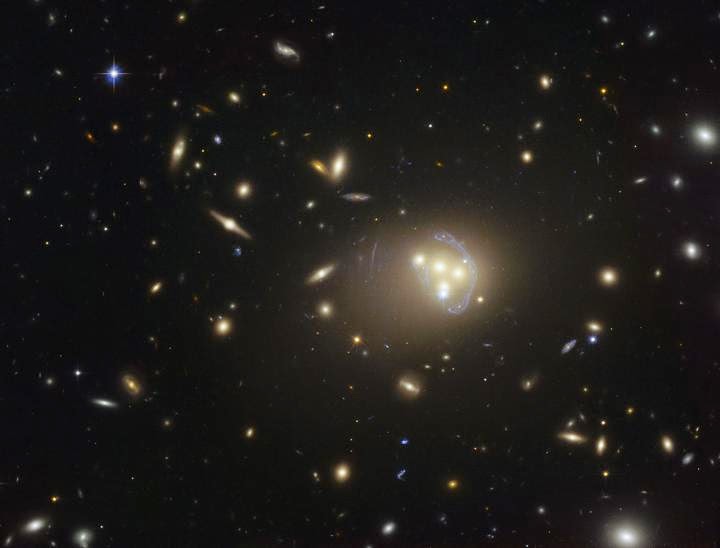| Online: | |
| Visits: | |
| Stories: |

| Story Views | |
| Now: | |
| Last Hour: | |
| Last 24 Hours: | |
| Total: | |
First Signs of Self-Interacting Dark Matter?
Using the MUSE instrument on ESO’s VLT in Chile, along with images from Hubble in orbit, a team of astronomers studied the simultaneous collision of four galaxies in the galaxy cluster Abell 3827. The team could trace out where the mass lies within the system and compare the distribution of the dark matter with the positions of the luminous galaxies.
This image from the NASA/ESA Hubble Space Telescope shows the rich galaxy cluster Abell 3827. The strange blue structures surrounding the central galaxies are gravitationally lensed views of a much more distant galaxy behind the cluster. Observations of the central four merging galaxies have provided hints that the dark matter around one of the galaxies is not moving with the galaxy itself, possibly implying dark matter-dark matter interactions of an unknown nature are occurring.
Our current understanding is that all galaxies exist inside clumps of dark matter. Without the constraining effect of dark matter’s gravity, galaxies like the Milky Way would fling themselves apart as they rotate. In order to prevent this, 85 percent of the Universe’s mass [1] must exist as dark matter, and yet its true nature remains a mystery.
In this study, the researchers observed the four colliding galaxies and found that one dark matter clump appeared to be lagging behind the galaxy it surrounds. The dark matter is currently 5000 light-years (50 000 million million kilometres) behind the galaxy — it would take NASA’s Voyager spacecraft 90 million years to travel that far.
A lag between dark matter and its associated galaxy is predicted during collisions if dark matter interacts with itself, even very slightly, through forces other than gravity [2]. Dark matter has never before been observed interacting in any way other than through the force of gravity.
Lead author Richard Massey at Durham University, explains: “We usedto think that dark matter just sits around, minding its own business, except for its gravitational pull. But if dark matter were being slowed down during this collision, it could be the first evidence for rich physics in the dark sector — the hidden Universe all around us.”
The researchers note that more investigation will be needed into other effects that could also produce a lag. Similar observations of more galaxies, and computer simulations of galaxy collisions will need to be made.
Team member Liliya Williams of the University of Minnesota adds: “We know that dark matter exists because of the way that it interacts gravitationally, helping to shape the Universe, but we still know embarrassingly little about what dark matter actually is. Our observation suggests that dark matter might interact with forces other than gravity, meaning we could rule out some key theories about what dark matter might be.”
This result follows on from a recent result from the team which observed 72 collisions between galaxy clusters [3] and found that dark matter interacts very little with itself. The new work however concerns the motion of individual galaxies, rather than clusters of galaxies. Researchers say that the collision between these galaxies could have lasted longer than the collisions observed in the previous study — allowing the effects of even a tiny frictional force to build up over time and create a measurable lag [4].
Taken together, the two results bracket the behaviour of dark matter for the first time. Dark matter interacts more than this, but less than that. Massey added: “We are finally homing in on dark matter from above and below — squeezing our knowledge from two directions.”
Contacts and sources:
Source:




